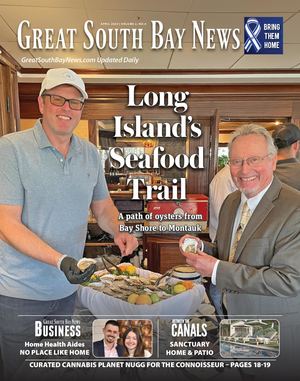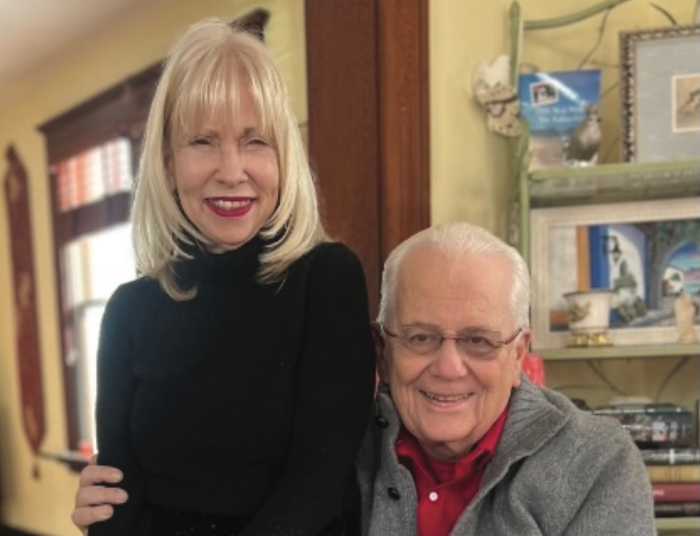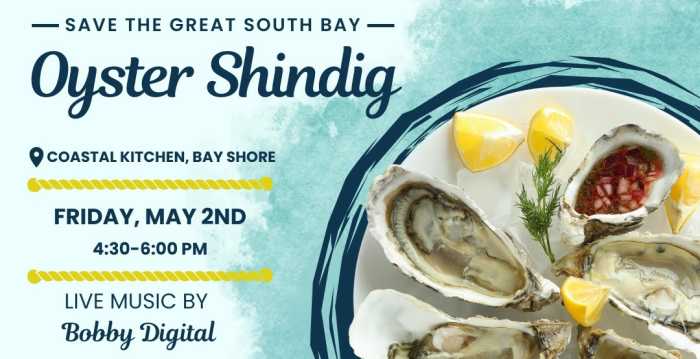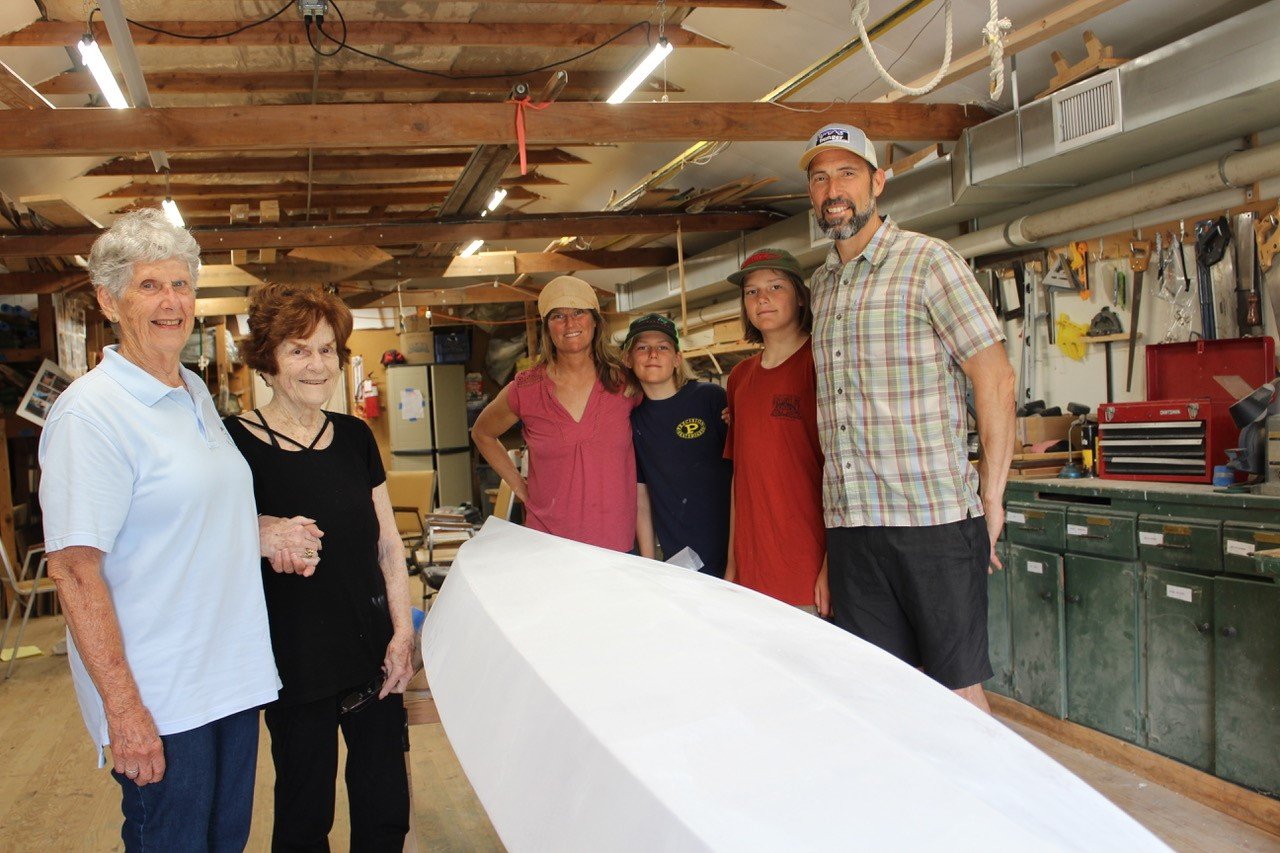
Owen and Kier Goeke (fourth and fifth from left) built a Chesapeake Light Craft Peeler skiff, a Family Boat Program at the Long Island Maritime Museum, guided by volunteer boat experts. Pictured with the boys, left to right, LIMM Vice Chair Betty Arink, Rhode McManus and Erin and Jules Goeke. Photo Linda Leuzzi
Three days a week for three hours or more from October to mid-May, Owen Goeke, almost 12, and his brother, Kier, 14, mostly devoted their time building a Chesapeake Light Craft Peeler at the Long Island Maritime Museum (LIMM). It was a first for the Oakdale brothers. They wanted a boat they could fish in on the Great South Bay.
That’s the short version of this story. There’s a longer version loaded with maritime history and family anecdotes coming. Hold on, mates.
“I’ve been trying to get this Family Boat Build program going for 10 years,” said Trustee and First Vice Chair Betty Arink, the coordinator of the Bob Grooms Moonbeam Boat Shop, who also oversees its maintenance. A LIMM devotee since 1995, she is a former Penn State University professor of Early Childhood and Physical Education.
“Then Erin walked in with the boys and asked if we would be interested in working with them and building a boat.”
The brothers go out on their neighbors’ boats, explained mom, and became interested in fishing two years ago. They even make their own fishing lures.
“Kier put together a boat,” said Erin of a rudimentary first attempt. “Then my mom Rhoda got us a membership to LIMM.”
There’s an ethereal quality to the LIMM campus, 14 acres off Montauk Highway and Atlantic Avenue in West Sayville, where the former Hard Estate, Meadowedge, once existed. The LIMM main building was the estate garage that now houses its offices and exhibits. The mansion was converted to Suffolk County government offices as well as a restaurant and catering hall, but a historical feel envelopes the property like a time warp.
There’s the 19th century Bayman’s Cottage, the Penney Boat Shop, the Everett-Lawrence Small Craft Building with over 75 restored vessels, and the Bob Grooms Moonbeam Boat Shop, a series of four small, connected structures where you can witness renovations underway.
Bob Grooms was a beloved volunteer. Arink worked with him building raffle boats to raise funds; they would repair and restore boats. The Moonbeam name is a nod to the elegant racing boats built by renowned Patchogue boat builder Gil Smith. The LIMM has one in their collection.
The “Priscilla,” an 1888 oyster sloop that sat in the water for years, gained prominence after restoration began by two shipwrights Josh Herman and Ricardo Vincente in 2002. It was a $400,000 16-month restoration and received National Historic Landmark status in 2006. It’s berthed next to the “Modesty,” another restored boat near wetlands where kingfishers and egrets can be seen.
“We knew there were master boat builders here,” Erin said. The boat volunteers work 9 a.m. to noon. They’d already left for the day last summer when Erin came with the boys, but then she spoke to Arink about their desire to build their own boat. Arink’s Family Boat Building dream took off.
What were the first steps Owen and Kier tackled on the project? “It comes in a flat box,” said Owen of the kit, which their grandmother, Rhoda McManus, paid for. She also took out the family membership which got them down there. “We took the pieces out, looked at the manual, and labeled them.”
What was the hardest part? “There’s a lot of sanding,” Owen said. “It’s tedious and tiring,” added Kier.
“The first time they were all over the place,” reported Arink of the sanding work. “But John McCardle was the lead volunteer on the project and guided them. He came in religiously over the three days the boys were here.”
You would want to be adopted by the Goeke family. They radiate kindness, interest, engagement in life. The boys are home schooled, but Erin refers to their education as field schooling.
“We take them out in nature, with hikes,” Erin said. “Also, they are such big readers. They come out with comments in the car sometimes I wonder `where did you get this?’ and they got it from books.”
Dad Jules is a science teacher in the Copiague School District. He and Erin are lifeguards during the summer at Robert Moses Beach. “They were in the water six or seven hours yesterday,” Jules said of his sons. “They’re water kids.” They’ve been surfing since they could practically walk.
As for the skiff, building it is no small feat. It’s 15 feet, 6 inches overall length, with a 6-foot, 3-inch beam, weighs 300 pounds and has a 1,000-pound maximum capacity weight. It’s constructed out of Okoume marine plywood covered with 3-ounce fiberglass cloth coated with three coats of Mas resin. The boat has both varnish and paint for its final finish. The construction style is called stitch and glue.
We’re still mounting the motor,” said Jules, of the 15 horsepower Honda 4 stroke engine he purchased for his sons. Electrical work is still needed; that will be done by a licensed mariner.
The boys said experience with their mentors have interested them in returning in the fall to assist on another boat building project.
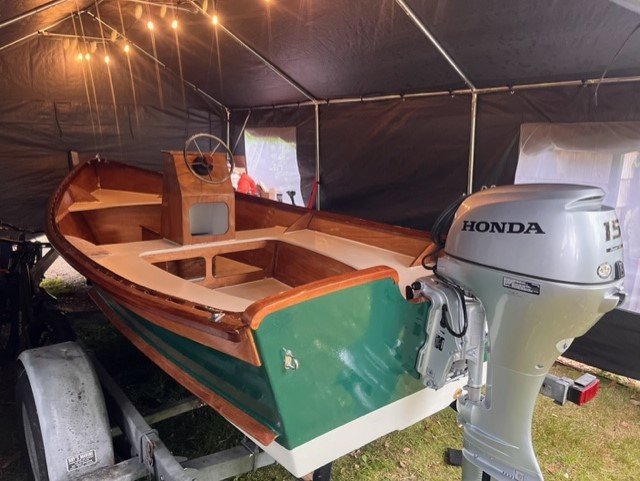
The skiff Owen and Kier Goeke built. LIMM Courtesy photo
